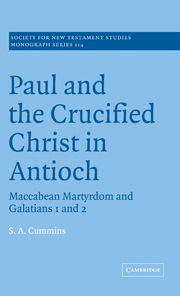Book contents
- Frontmatter
- Contents
- Preface
- List of abbreviations
- Introduction
- Part One MACCABEAN MARTYRDOM
- Part Two PAUL AND THE CRUCIFIED CHRIST IN ANTIOCH
- 3 Paul as a paradigm of conformity to Christ: the Galatian context, conceptual framework and autobiography
- 4 Jews and Christians in Antioch
- 5 Paul and the crucified Christ in Antioch: Galatians 2.11–14
- 6 Paul and the crucified Christ in Antioch: Galatians 2.15–21
- Conclusion
- Bibliography
- Index of passages
- Select index of Greek words and phrases
- Index of modern authors
- Select index of names and subjects
5 - Paul and the crucified Christ in Antioch: Galatians 2.11–14
Published online by Cambridge University Press: 22 September 2009
- Frontmatter
- Contents
- Preface
- List of abbreviations
- Introduction
- Part One MACCABEAN MARTYRDOM
- Part Two PAUL AND THE CRUCIFIED CHRIST IN ANTIOCH
- 3 Paul as a paradigm of conformity to Christ: the Galatian context, conceptual framework and autobiography
- 4 Jews and Christians in Antioch
- 5 Paul and the crucified Christ in Antioch: Galatians 2.11–14
- 6 Paul and the crucified Christ in Antioch: Galatians 2.15–21
- Conclusion
- Bibliography
- Index of passages
- Select index of Greek words and phrases
- Index of modern authors
- Select index of names and subjects
Summary
Paul's autobiography climaxes with an account of, and theological reflection upon, his dramatic confrontation with Peter in Antioch (Gal. 2.11–14, 15–21). It has already been contended that the apostle's autobiographical remarks to date (chapter three), and the external evidence on Jewish and Christian relations in Antioch (chapter four) are both greatly illuminated when seen as a christological reworking of the Maccabean martyr model of Judaism (chapters one and two). The same claim will now be advanced concerning the Antioch incident (chapters five and six). Here, Paul again emerges as one standing in ironic relation to the Maccabean tradition as he now responds to Peter's movement in the direction of a rigorous Judaism by faithfully defending the truth of the gospel, namely, the outworking of God's grace in the martyred and exalted Jesus, Messiah and Son of God, and in the eschatological people of God together conformed to him.
At the outset I provide a brief introductory overview of the story-line of Galatians 2.11–21 as a whole, illustrating how this represents a christological reworking of the Maccabean narrative as, for example, exemplified in the story of the martyr Eleazar. The chapter then focuses specifically upon the account of the Antioch confrontation itself (Gal. 2.11–14). Our point of departure is the much debated question of the precise nature of the Antiochene table-fellowship, which also considers the related (but often overlooked) matter of the Lord's Supper.
- Type
- Chapter
- Information
- Paul and the Crucified Christ in AntiochMaccabean Martyrdom and Galatians 1 and 2, pp. 161 - 188Publisher: Cambridge University PressPrint publication year: 2001



